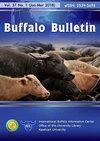Assaying the concentration of immunoglobulin G in colostrum from females postpartum and serum from neonatal calves of buffaloes (Bubalus bubalis)
IF 0.2
4区 农林科学
Q4 AGRICULTURE, DAIRY & ANIMAL SCIENCE
引用次数: 1
Abstract
Neonatal ruminants are born without any humoral immunity due to lack of placental transfer of immunoglobulins during gestation. This predisposes the newborn buffalo calves to a high incidence of morbidity and mortality on exposure to infectious agents. Colostrum is the first milk produced by the females after calving and is a rich source of immunoglobulins, especially immunoglobulin G (IgG). The immunocompetence of the neonates can be boosted by feeding them sufficient amount of good quality colostrum within a few hours after birth. Optimal colostrum management at a farm not only reduces the occurrence of diseases among the younger stock but also enhances their growth performance and productivity once they are adults. In the present study, eighty animals at a Murrah buffalo farm were screened for the concentration of IgG in the colostrum collected from recently parturated females and in the serum collected from their calves within 6 to 12 h of colostrum consumption to determine the status of transfer of passive immunity. Indirect ELISA was used to estimate the IgG levels. The overall mean (range) of colostral and serum IgG concentration was found to be 50.44±3.36 (12.71 to 227.78) and 10.85±0.62 (0.25 to 19.88) mg/ml, respectively for all the 80 animals. Routine screening of buffaloes, in a similar way, will help to reduce calf deaths due to immunodeficiency.产后母水牛初乳和新生水牛血清中免疫球蛋白G的含量测定
由于妊娠期缺乏免疫球蛋白的胎盘转移,新生反刍动物出生时没有任何体液免疫。这使刚出生的水牛幼崽在接触传染源时易发生高发病率和高死亡率。初乳是雌性产仔后生产的第一种牛奶,是免疫球蛋白的丰富来源,尤其是免疫球球蛋白G(IgG)。新生儿的免疫能力可以通过在出生后几个小时内给他们喂食足够量的优质初乳来提高。农场的最佳初乳管理不仅减少了年轻牲畜的疾病发生,而且提高了它们成年后的生长性能和生产力。在本研究中,对Murrah水牛养殖场的80只动物进行了从刚分娩的雌性动物身上采集的初乳中以及在食用初乳6-12小时内从其小牛身上采集血清中IgG浓度的筛查,以确定被动免疫的转移状态。间接ELISA用于估计IgG水平。发现所有80只动物的结肠和血清IgG浓度的总体平均值(范围)分别为50.44±3.36(12.71至227.78)和10.85±0.62(0.25至19.88)mg/ml。以类似的方式对水牛进行常规筛查,将有助于减少因免疫缺陷而导致的小牛死亡。
本文章由计算机程序翻译,如有差异,请以英文原文为准。
求助全文
约1分钟内获得全文
求助全文
来源期刊

Buffalo Bulletin
AGRICULTURE, DAIRY & ANIMAL SCIENCE-
CiteScore
0.50
自引率
0.00%
发文量
53
审稿时长
>12 weeks
期刊介绍:
Buffalo Bulletin is published quarterly in January-March, April-June, July-September and October-December. Contributions on any aspect of research or development, progress reports of projects and news on buffalo will be considered for publication in the bulletin.
 求助内容:
求助内容: 应助结果提醒方式:
应助结果提醒方式:


